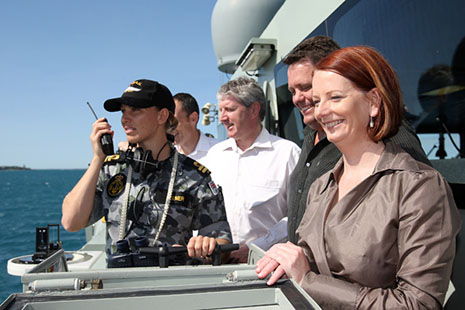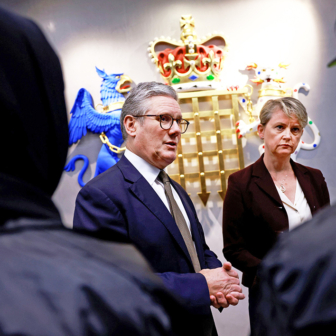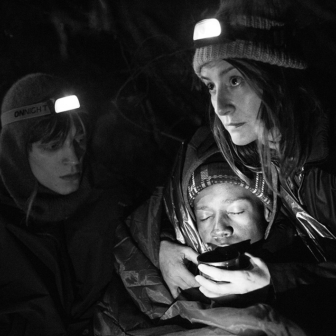THE POLITICS of asylum mobilises something deep and dark in many Australians. But though Tony Abbott and others might consider it to be their reliable instrument for re-election, the messy fact is that this divisive complex of issues is capricious and destructive for almost all involved.
Very few people are talking about the one aspect of these issues that has expanded and thrived without pause – border security itself. Regardless of who gets elected, and whatever other promises they break in the process of getting in, they will still promise to protect you, no matter what, from threatening, border-crossing monsters. And they’re not afraid of scaring you to get the authority to do so.
On 10 April 1999, a boat travelling from the People’s Republic of China arrived in Scotts Head, near Nambucca Heads in New South Wales. The Scotts Head landing made no lasting mark on the national imagination. But it did enable the secretary of the prime minister’s department, Max “the Axe” Moore-Wilton, to begin laying the groundwork for the implementation of border security. On 12 April 1999, a mere two days after the Scotts Head incident, the prime minister established a Coastal Surveillance Task Force, chaired by Moore-Wilton. On 27 June 1999, barely six weeks later, the prime minister announced that the government would implement all of the task force’s recommendations for tightening the borders.
The Scotts Head incident also contributed to a hazy conflation in thinking on national security whereby the government considered people crossing the borders to be part of a broader, unified security threat that encompassed such previously disparate phenomena as terrorism, disease, welfare dependency and, now, asylum seekers. Throughout the 90s politicians and government agencies had been drawing together these heretofore separate issues through increasingly strident calls to control human transborder mobility as an urgent and vital matter of state sovereignty. (This process of naming and claiming was never entirely cynical, nor was it the symptom of some kind of unconscious wish – though those factors doubtless played a part. Then, as now, the agents involved in this process sincerely believed in the rising threats, even if they were, as is often said about Tony Blair in relation to Iraq, “sincerely wrong.”) Once this translation was complete, the nation’s borders were recast as the site of security, and the crossers of those borders could be viewed as categorical threats: to the border, and therefore to security.
At this stage, as David Marr and Marian Wilkinson’s Dark Victory points out, the new whole-of-government approach led by Max the Axe “remained civilian” – this was not yet a full-blown border-security response in the profoundly new sense that I will shortly describe. The setup was being carefully and deliberately set up, but what was now needed was “luck” – preparation would have to meet opportunity. And in August 2001, that is precisely what happened, when MV Tampa rescued the occupants of the Palapa.
The Tampa trigger enabled the implementation of three key legislative changes that have become the legal infrastructure of the “new normal” of border security. The first of these validated the government’s actions and generated new protection powers, including the power of interdiction; the second amended the Migration Act 1958 to remove certain territories, including Christmas Island, from the migration zone, re-specifying them as “offshore excised places.” These amendments also added the new category of “offshore entry person.” The third piece of legislation, the Consequential Provisions Act, enabled authorities to detain “offshore entry persons” “in Australia” or transfer them to a “declared country.”
The first and second pieces of legislation, which for simplicity’s sake can be characterised as covering interdiction and excision respectively, enabled the legal functioning of the massive new enforcement arm of border security. From late 2001 until October 2006, this enforcement arm was called Operation Relex. Relex involved using all three branches of the Australian Defence Force to “detect, deter and return” “Suspected Unlawful Non Citizens,” or SUNCs, aboard “Suspected Illegal Entry Vehicles,” or SIEVs.
Operation Relex was something profoundly new for the Australian Defence Force. By way of contrast, since the arrivals of people fleeing Vietnam in the late 70s, the navy’s role in analogous historical cases had been to escort boats to Australian ports, where they would be received and processed by immigration authorities as an immigration matter. The new role consisted of personnel from the navy, army, air force, customs, federal police and quarantine actively preventing boat arrivals from reaching Australian territory.
In 2004, the Howard government received a report from an inquiry into the state of Australia’s coastal surveillance arrangements. The report recommended the formation of the Joint Offshore Protection Command, which was renamed and permanently instituted as the Border Protection Command, the BPC, in October 2006. The BPC effectively rolled Operation Relex’s spectacular enforcement methods into an ensemble of quiet, continuous, scrupulous border surveillance and enforcement measures, all operating under the general rhetorical heading of “border security” (or, interchangeably, border protection). This date, much more than the trigger of Tampa, marks the point from which the key transformation to border security came into full and permanent effect.
The BPC’s role and scope, as avowed by its website, provide an insight into the logic and ethos of border security. The BPC has an extraordinarily broad mandate, tied to an extremely wide and loose yet categorical description of the threats that motivate its existence.
In its own words, the BPC is tasked with providing “security for Australia’s offshore maritime areas.” It is “responsible for coordinating and controlling operations to protect Australia’s national interests.” Of boat arrivals, the BPC’s website explains the following: “Australia’s national interests are threatened by any unauthorised arrival of people.”
In mobilising the power of the “national interest” and recognising any “unauthorised arrival of people” as a threat to that interest, the BPC generates the permanent, categorical necessity of interdicting all irregular maritime arrivals and transferring them to Christmas Island for detention and processing. It’s curious that, once transferred for processing, the arrivals are no longer considered as threats, but as the recipients of careful processing which, under the Rudd government and in all likelihood under the Gillard government, must also be defensibly humane. Somehow, between the moment of interdiction and the transfer by boat into the excision, whatever was threatening about unauthorised arrivals is neutralised.
The BPC operates away from representation, discussion and politicisation. It’s true that it is highly visible on the screens of the nation, but only when it swoops down and interdicts, when it is represented on commercial TV or when it is visited by a new PM with an election to call. Otherwise, Border Protection Command is mostly invisible and silent – but “we” know, somehow, that it is out there quietly performing the translation of threats into humanely processed asylum seekers.
It is tempting to view everything mentioned thus far as historical relic, the unfortunate inheritance or the unloved relation of the contemporary iteration of party politics in relation to this complex of matters. Border Security still airs on Channel 7, true, but it is no longer number one. And despite the mimetic proliferation of analogous border/security programming, it could be a faded concept from a fading era. To which I would reply by quoting The Usual Suspects quoting Baudelaire: “the greatest trick the devil ever pulled was convincing the world he didn’t exist.” Border security isn’t disappearing, it now simply goes almost without saying.
In July 2008, the new immigration minister, Senator Chris Evans, delivered a speech entitled “New Directions in Detention,” which clearly set out the recently elected Rudd Labor government’s desired values and models for immigration detention, and outlined how they would be translated into robust processes and durable structures. As it was a statement of change intended, as much as possible, to differentiate the Rudd Labor government from the “bad old days” of Howard, Ruddock, Reith, Vanstone and Max the Axe by offering new directions, it is an ideal jumping-off point for demonstrating how border security has become as ambient and odourless as the air we breathe.
Evans’s speech included some assertions of commitment to compassion, dignity, tolerance and “humane conditions.” But importantly, it subordinated these concepts to the higher aim of maintaining systemic integrity, which, in turn, was placed under the superlative of security (which, of course, means border security). Senator Evans summarised the new directions as follows: “In the future the immigration system will be characterised by strong border security, firm deterrence of unauthorised arrivals, effective and robust immigration processes and respect for the rule of law and the humanity of those seeking migration outcomes.”
The implementation of many of the measures from “New Directions” has stabilised and made concrete the function of the BPC. (As the document asserts, “[c]ontrol and management of our borders is integral to the nation’s security. The extensive patrolling of our borders by Defence, Customs and other law enforcement agencies has been maintained at existing levels.”) Second, it has entrenched the excision by representing it not only as normal, proper and prudent, but also as compatible with “humane” treatment. This went some way towards meeting the objections under international law made by prominent human-rights advocates and the concern about care for vulnerable, traumatised people often emphasised by refugee advocates and Christian NGOs – overcoming probable electoral obstacles for Labor in the process.
“NEW DIRECTIONS” was the closest that Rudd Labor came to articulating a different approach to this troubling complex of boats and people. But the new directions in “New Directions” failed to indicate any meaningful way out of the labyrinth of border security and also involved Labor in the schizoid politics of “tough but humane.” For a party that still, in spite of everything, dwells among the spectres of the (white, male, Australian) workers of the world, and thus must at least pay lip service to things like equality and social justice, the sacred duties imposed by border security place any Labor government in an incredibly costly bind. There’s an interesting contrast that can be drawn here. Rudd picked a fight with big mining, and lost. But consider: Kevin Rudd didn’t even pick a fight with border security, but border security still beat him.
On 6 July 2010, the new prime minister, Julia Gillard, delivered her key speech on border security (to date). “Moving Australia Forward” was a complicated political speech with something for everyone. The speech had a quiet protagonist, one capable of responding to all the desires of its disparate audiences. Indeed, border security is so natural now, it no longer even needs to be argued in topic sentences, stand-alone statements or assertive phrasing. Instead, Prime Minister Gillard wove border security in as one quiet, essential thread in a policy braid that she presented as a measured, considered, humane response to a “difficult problem.”
The speech contained a laudable number of facts and reintroduced important historical context erased and re-erased by the Liberals in government and opposition. But it also sought to split the world into a good, deserving “we” and a bad, undeserving “them.” On the good, deserving side are Gillard and her parents, Frank Lowy himself, and generic Aussie battlers (still doing it tough, even after all these years). On the other side are the bad old Liberals and the people smugglers. “[O]ur nation would not leave children to drown,” she said. “We are Australian and our values will never allow us to countenance that kind of evil… people smuggling is an evil trade to be punished.”
Gillard mobilises this instantly recognisable hagiography of the good, the bad and the ugly to move border security beyond “we will decide” and into the territory of what the ABC’s Kerry O’Brien recently described as “the ethical right to return [asylum seekers] to the country they came from.” In Australia 2010, border security is not just necessary, it is somehow the right right, the proper thing that good people (deserving Australians) do, not just because they are threatened, but, on the contrary, as a spontaneous outpouring of their inherent values. “Australia’s basic decency,” Gillard said, “does not accept the idea of punishing women and children by locking them up behind razor wire or ignoring people who are fleeing genocide, torture, and persecution; nor does it allow us to stand back and watch fellow human beings drown in the water, but equally,” and here comes the swerve, “there is nothing inconsistent between these decencies and our commitment to secure borders and fair, orderly migration.”
“Moving Australia Forward” reintroduced important, valuable complexities into what has become a corrupted, nasty debate. Fundamentally, however, what it called for, when all is said and done, was more money, resources and prestige for border security. Gillard ended the speech by drawing out the following entailments: “We are also investing in eight new patrol boats with improved surveillance and response capability – strengthening our Border Protection Command, which already has 18 vessels and 18 aircraft available for patrolling Australian waters all year round. We already have more assets deployed for this task than any other Australian Government has ever had. We ultimately destroy the illegal boats we intercept… If re-elected I will legislate to toughen these measures further, increasing maximum penalties for situations where a people-smuggling venture results in death.”
In this year’s budget (supposedly a belt-tightening budget, one that required breaking promises on mental health and homelessness) the Commonwealth announced a further $4.3 billion of national security spending. This is new money. Around $1.2 billion of that budget will be ploughed into border security, with more than $143 million to increase capacity in immigration detention centres and $22 million to be spent on upgrades at the main detention centre on Christmas Island. The enforcement is being reinforced. And in the wake of “Moving Australia Forward” PM Julia Gillard announced a further $25 million for more forces and patrol boats for Indonesia. The reinforcements are being reinforced.
And troublingly, according to border protection’s own avowed aims (reducing numbers, saving money, decreasing violence and safety-at-sea issues), none of it works. The many thousands of agents, officers and institutions involved in border security – including ASIO, as of this year – have had a decade to get this right, with resources and political carte blanche from the electorate that would be the envy of any other government department, and very modest numbers to have to manage. And yet the involvement of organised crime syndicates is intensifying, as are the violent measures taken by those who do embark. This is something involved agencies have known about for a decade. In 2000, the Australian Federal Police’s website openly discussed these emerging tendencies in people smuggling. In 2002, the executive summary of the Senate’s A Certain Maritime Incident report drew another connection between intensified criminal activity and increasing violence. There, however, the generator of violence was the act of militarised interdiction itself: “The new Australian response led to a corresponding change in the behaviour of the asylum seekers. From being cooperative and compliant, their behaviour changed to include threatened acts of violence, sabotage and self-harm, designed to counter the Navy’s strategies.”
Border security enacts mutual pathological learning processes that are themselves generative: they have complex effects, many of them unanticipated, some of them extremely pernicious and potentially destabilising, some of them irreversible. One of these is the perverse effect that an over-resourced, whole-of-government approach has on itself. In the absence of boat arrivals, the BPC’s first major mission involved smashing up fishing in those areas of Australia’s Exclusive Economic Zone closest to Indonesia. Given the complexity involved, it is impossible to draw a clear causal link between this mission and a rise in the number of boats carrying people seeking asylum. But it seems reasonable to assume that, by increasing the risk of fishing those waters, the BPC made the riskier but much more profitable business of people smuggling appear appealing to some.
The second perverse, generative effect is the way that interdiction itself almost guarantees safe passage to detention. Formerly, smugglers required older, experienced fishermen with extensive knowledge of the waters, currents and other hazards between Java and north-western Australia, on the presumption that any boat that departed Indonesia would, plausibly, make it all the way to Christmas Island or even the north-west coast of the Australian mainland. But, in practice, with interdiction undertaken from the moment a vessel suspected of carrying people suspected of not having visas enters the Exclusive Economic Zone, passengers and pilot and crew can reasonably assume that they will be picked up long before they get into serious trouble on the high seas. Of course, there are no categorical guarantees here.
But more than anything, enacting the metaphor of border security has material effects that commit all involved to the erection and maintenance of costly, grotesque, durable structures. The crowning example is the Christmas Island Immigration Detention Centre, or IDC. The IDC is a high-tech, medium-security prison, situated in the middle of a rainforest on the west part of an island more than 2600km from the Australian mainland. The IDC is in a national park, but the construction process was exempt from the usual environmental oversights on the grounds of national security. It cost over $500 million to build, making it one of the most expensive public works buildings of its era, and it costs more than $34 million a year to run, much of that regardless of whether it is used. And when it is used, as the government has been using it since 2009, it is almost completely useless. It is considered to be inappropriate for women and children. Both the Australian Human Rights Commission and Amnesty International consider it inappropriate accommodation for anyone. But it does have a high-power electric fence. And another, second microwave fence. And every cubic centimetre of it can be monitored on CCTV from Canberra.
The Christmas Island IDC is one of the rare moments when a utopia takes concrete form. It is what happens to dreams, when dreams become concrete. It might also be embodied proof of Goya’s reminder: the sleep of reason produces monsters. The IDC also puts paid to any notion you ever had that the Howard government, even in its rare “wild” moments, ever thought there would be significant numbers arriving. Recall: it is only designed to house 420 people, with contingency accommodation for a further 420. If a few hundred men arrived each year, and no one else, it would be inappropriate, but adaptable. Given either larger numbers arriving (including any number of women and children), or no people at all, it is a totally dysfunctional monster. It was built to spill, and it has, necessitating further construction near the purpose-built IDC, and the resumption of a growing archipelago of sites and facilities on the mainland such as Baxter and Leonora. But perhaps it’s not dysfunctional, in that it’s not meant to “work” in this way: it was never intended to, and it isn’t expected to any time soon. Perhaps its monstrosity is intentional: it’s meant to teach us all a lesson. But what that lesson is depends, precisely, on what we choose to learn. •




